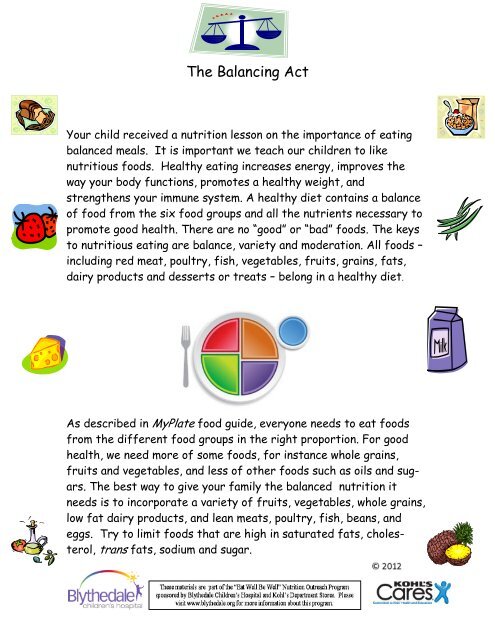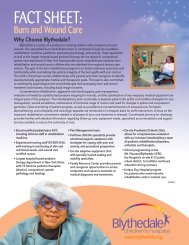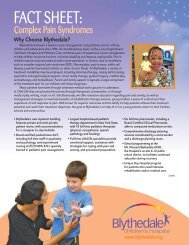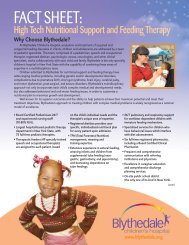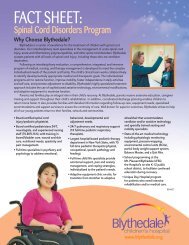Building Balanced Meals - Blythedale Children's Hospital
Building Balanced Meals - Blythedale Children's Hospital
Building Balanced Meals - Blythedale Children's Hospital
Create successful ePaper yourself
Turn your PDF publications into a flip-book with our unique Google optimized e-Paper software.
The Balancing Act<br />
Your child received a nutrition lesson on the importance of eating<br />
balanced meals. It is important we teach our children to like<br />
nutritious foods. Healthy eating increases energy, improves the<br />
way your body functions, promotes a healthy weight, and<br />
strengthens your immune system. A healthy diet contains a balance<br />
of food from the six food groups and all the nutrients necessary to<br />
promote good health. There are no “good” or “bad” foods. The keys<br />
to nutritious eating are balance, variety and moderation. All foods –<br />
including red meat, poultry, fish, vegetables, fruits, grains, fats,<br />
dairy products and desserts or treats – belong in a healthy diet.<br />
As described in MyPlate food guide, everyone needs to eat foods<br />
from the different food groups in the right proportion. For good<br />
health, we need more of some foods, for instance whole grains,<br />
fruits and vegetables, and less of other foods such as oils and sugars.<br />
The best way to give your family the balanced nutrition it<br />
needs is to incorporate a variety of fruits, vegetables, whole grains,<br />
low fat dairy products, and lean meats, poultry, fish, beans, and<br />
eggs. Try to limit foods that are high in saturated fats, cholesterol,<br />
trans fats, sodium and sugar.
Everyone has personal likes and dislikes, but that should not rule out<br />
a whole food group. Encourage your child to taste everything, but do<br />
not force him/her to eat. Because children are picky eaters by<br />
nature, it may be necessary to present them with a new food<br />
numerous times before they actually eat it on their own. Serving a<br />
different variety of healthy foods each day will help your child get<br />
all the essential nutrients even if he/she doesn’t eat some of the<br />
foods on a particular day.<br />
Enjoy these vitamin-packed recipes:<br />
Strawberry Orange Smoothie<br />
1/4 cup calcium-fortified orange juice<br />
1/2 cup lowfat plain yogurt<br />
1/2 cup strawberries, quartered (fresh<br />
or frozen)<br />
Instructions:<br />
Combine all ingredients in blender.<br />
Blend on high speed until smooth.<br />
Makes 1 cup<br />
Tomato Barley Minestrone<br />
1 Tbsp. olive oil<br />
2 carrots, sliced<br />
2 stalks celery, chopped<br />
2 onions, chopped<br />
1 Tbsp. minced garlic<br />
1/2 cup uncooked quick barley<br />
2 (14 oz.) cans diced tomatoes, undrained<br />
6 cups low sodium vegetable broth<br />
14 oz can garbanzo or kidney beans,<br />
drained & rinsed<br />
1/4 tsp. pepper<br />
1/4 tsp. thyme<br />
Soup Preparation<br />
In heavy saucepan, heat olive oil; add carrots, onions, and garlic. Cook and stir over<br />
medium heat until vegetables are crisp tender, about 6 minutes.<br />
Meanwhile, in another heavy saucepan combine all remaining ingredients and bring to a<br />
boil over medium heat. Add sauteed carrot mixture and bring to a boil again. Reduce<br />
heat to low, cover, and simmer until barley is tender, about 15 minutes.<br />
Makes 4 servings


